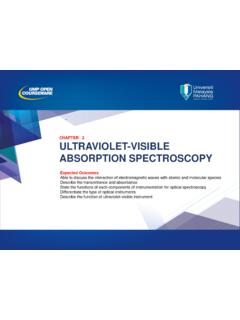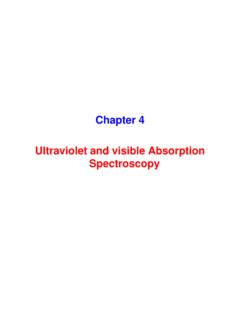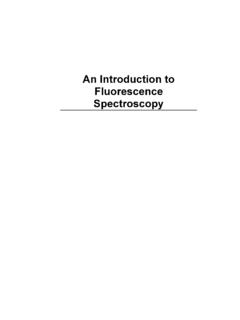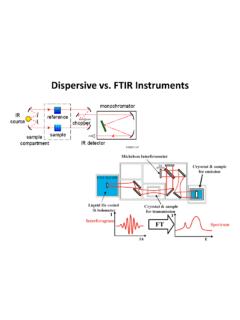Transcription of Experiment 7: Spectrum of the ... - Columbia University
1 INTRO TO EXPERIMENTAL PHYS-LAB 1493/1494/2699 Experiment 7: Spectrum of the hydrogen Atom Nate Saffold Office Hour: Mondays, 5:30-6:30 PMPHYS 1493/1494/2699: Exp. 7 spectrum of the hydrogen Atom2 Introduction The physics behind: The Spectrum of light The empirical Balmer series for hydrogen The Bohr model (a taste of Quantum Mechanics) Brief review of diffraction The Experiment : How to use the spectrometer and read the Vernier scale Part 1: Analysis of the Helium (He) Spectrum Finding lattice constant of the grating Part 2: Measuring spectral lines of hydrogen (H) Determining the initial state of the electron3 Light Spectra Isaac Newton (1670): shine sunlight through prism and you will observe continuous rainbow of colors.
2 John Herschel (1826): shine light from heated gas through spectroscope, and you will observe monochromatic lines of pure color on a dim/dark ! Still s rainbowHerschel s linesPHYS 1493/1494/2699: Exp. 7 spectrum of the hydrogen Atom4 Discharge lamps and artificial light Herschel's discovery of emission spectra from heated gas was studied extensively in the 1800's. It was realized that a heated gas emits a unique combination of colors, called emission Spectrum , depending on its composition. Example: Helium gas in a discharge lamp. Main idea: put a large voltage across the gas. It will break down and emit light. The light emitted is composed of discrete 1493/1494/2699: Exp. 7 spectrum of the hydrogen Atom5 Atomic spectra This is an example of the lines emitted from different gasesPHYS 1493/1494/2699: Exp.
3 7 spectrum of the hydrogen Atom6 Interlude: Spectra in Astronomy In the 19th century astronomers realized that spectroscopy can be used as a powerful tool to study stars 1802: William Wollaston observed sunlight separated into colors by a prism; he noticed dark lines in the Spectrum at definite locations. 1817: Joseph Fraunhofer observed these spectral lines in other stars as well. Sometimes they are the same, sometimes they are different. They correspond to the absorption (not emission!) of some wavelengths due to the most external elements of the solar gas Implication: The stars are made of the same stuff as Earth!PHYS 1493/1494/2699: Exp. 7 spectrum of the hydrogen Atom7 Interlude: How stars emit light Emitted Spectrum : Very hot stellar center emits continuous (blackbody) radiation From the core all the wavelengths are emitted (just like a rainbow) Observed Spectrum : Before arriving to us the light passes through surface of stars Gases at surface absorb light at characteristic wavelengths Therefore, we detect all the wavelengths but the one absorbed.
4 This generates the Fraunhofer s lines visible lightPHYS 1493/1494/2699: Exp. 7 spectrum of the hydrogen Atom8 Interlude: How stars emit light Star's absorption Spectrum :PHYS 1493/1494/2699: Exp. 7 spectrum of the hydrogen Atom9 The Balmer formula Balmer discovers (1885) that the quantized (discrete) visible emission Spectrum of the hydrogen follows a mathematical formula: He found the following expression for the wavelength of the absorption lines completely empirically. He did not provide any physical explanation for it: Different values of nf correspond to different line series discovered by several scientists before Balmer himself: nf = 1 (Lyman Series) nf = 2 (Balmer Series) which is visible nf = 3, 4, 5.
5 (Paschen, Brackett, Pfund)PHYS 1493/1494/2699: Exp. 7 spectrum of the hydrogen Atom10 For the Balmer series ( visible Spectrum ) we fix nf = 2 If we then change ni we obtain: ni = 3 yields = 656 nm (red) ni = 4 yields = 486 nm (green) ni = 5 yields = 433 nm (blue) ni = 6 yields = 410 nm (purple) The Balmer s equation describes the observed lines very accurately But what is the physics?Example: the visible spectrumNOTE: in the real Experiment you will perform: 1. Green looks bluish-green 2. Blue looks purple 3. Purple looks dark violet. It will be very hard to PHYS 1493/1494/2699: Exp. 7 spectrum of the hydrogen Atom11 Bohr s model for H atom In 1913 Neils Bohr proposed a physical model to describe the Spectrum of the hydrogen atom.
6 It was the birth of Quantum Mechanics! He hypothesizes that the angular momentum of an electron in orbit around a proton is quantized ( it can only be a discrete multiple of a certain number): Under this simple assumption he managed to compute the energy of the electron around the atom: As a consequence, the energy of the electron around the nucleus is also quantized!PHYS 1493/1494/2699: Exp. 7 spectrum of the hydrogen Atom12 Bohr s model for H atom In a real life Experiment we can never measure the energy of the electron. We can however measure differences in its energy Suppose that an electron makes a transition from a level ni to a level nf (with ni > nf) In order to conserve energy it will have to emit a photon with energy exactly E = E = Eni Enf Quantum mechanically the energy of a single photon is related to its wavelength as E = hc/ Therefore, the wavelength of the emitted photon is: This perfectly describes the Spectrum of the hydrogen atom!
7 PHYS 1493/1494/2699: Exp. 7 spectrum of the hydrogen Atom13 Towards Quantum Mechanics The Bohr s model was a very first step towards a new paradigm of physics It still had unresolved problems like: Could not capture some subtle properties of H atoms Does not apply to other kinds of elements Eventually the development of Quantum Mechanics (1920's) lead to a description of matter that is still in agreement with experiments today However, the main idea present in the Bohr s model remains: some physical quantities like energy and angular momentum can be discrete. This changes everything!PHYS 1493/1494/2699: Exp. 7 spectrum of the hydrogen Atom14 spectroscopy How can we measure the energy levels ( Spectrum ) of the hydrogen atom?
8 We CANNOT measure individual energy levels! We ARE ABLE TO measure indirectly the transition of an electron from one state to another. Absorption and emission of 1493/1494/2699: Exp. 7 spectrum of the hydrogen Atom15 spectroscopy How can we measure the energy levels ( Spectrum ) of the hydrogen atom? We CANNOT measure individual energy levels! We ARE ABLE TO measure indirectly the transition of an electron from one state to another. Absorption and emission of photons. Absorption spectroscopy : Shine a range of various wavelength radiation on a sample and measure the wavelengths that get absorbed (excitation of atoms). Not the kind of spectroscopy we will use Emission spectroscopy : Given a sample of excited atoms, measure the radiation that is emitted by the atoms.
9 This will be the principle behind this week's 1493/1494/2699: Exp. 7 spectrum of the hydrogen Atom16 The emission Spectrum of hydrogen Energy levels of the hydrogen atom:De-excitation of electron results in emission of eVEPHYS 1493/1494/2699: Exp. 7 spectrum of the hydrogen Atom17 The emission Spectrum of hydrogen Lyman series: It is made of all the de-excitations that end up on the nf = 1 level Infinite number of them: ni = 2, 3, 4, .. nf = 1 Unfortunately the Lyman series is not visible with the naked eye. Wavelengths are in the ultraviolet 1493/1494/2699: Exp. 7 spectrum of the hydrogen Atom18 The emission Spectrum of hydrogen Balmer series: All de-excitation emissions to the nf = 2 state Infinite number of them: ni = 3, 4, nf = to the Lymann one, the Balmer series is visible to the naked eye!
10 PHYS 1493/1494/2699: Exp. 7 spectrum of the hydrogen Atom19 Review: interference of light Question: How can we measure the wavelength of the emitted light? Answer: We can use interference! Recall: For slits with spacing d, the condition for constructive interference (bright spots) is:PHYS 1493/1494/2699: Exp. 7 spectrum of the hydrogen Atom20 Review: interference of light One feature of this equation is the it is wavelength dependent. Consequence: Each wavelength will interfere at a different angle: A diffraction grating can be used as a wavelength separator!PHYS 1493/1494/2699: Exp. 7 spectrum of the hydrogen Atom21 The ExperimentPHYS 1493/1494/2699: Exp. 7 spectrum of the hydrogen Atom22 Main goals As usual this Experiment is divided in two parts.



















